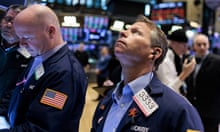Four decades ago, Silicon Valley Bank (SVB) was born in the heart of a region known for its technological prowess and savvy decision making.
The California-headquartered organisation grew to become the 16th largest bank in the US, catering for the financial needs of technology companies around the world, before a series of ill-fated investment decisions led to its collapse.
What happened to SVB?
As the preferred bank for the tech sector, SVB’s services were in hot demand throughout the pandemic years.
The initial market shock of Covid-19 in early 2020 quickly gave way to a golden period for startups and established tech companies, as consumers spent big on gadgets and digital services.
Many tech companies used SVB to hold the cash they used for payroll and other business expenses, leading to an influx of deposits. The bank invested a large portion of the deposits, as banks do.
The seeds of its demise were sown when it invested heavily in long-dated US government bonds, including those backed by mortgages. These were, for all intents and purposes, as safe as houses.
But bonds have an inverse relationship with interest rates; when rates rise, bond prices fall. So when the Federal Reserve started to hike rates rapidly to combat inflation, SVB’s bond portfolio started to lose significant value.
If SVB were able to hold those bonds for a number of years until they mature, then it would receive its capital back. However, as economic conditions soured over the last year, with tech companies particularly affected, many of the bank’s customers started drawing on their deposits.
SVB didn’t have enough cash on hand, and so it started selling some of its bonds at steep losses, spooking investors and customers.
It took just 48 hours between the time it disclosed that it had sold the assets and its collapse.
What triggered the run on the bank?
Given banks only keep a portion of their assets as cash, they are susceptible to a rush of demand from customers.
While SVB’s problems stem from its earlier investment decisions, the run was triggered on 8 March, when it announced a $1.75bn capital raising. It told investors it needed to plug a hole caused by the sale of its loss-making bond portfolio.
“Suddenly everyone became alarmed that the bank was short of capital,” says Fariborz Moshirian, professor at UNSW and director of the Institute of Global Finance.
Customers were now aware of the deep financial problems at SVB, and started withdrawing money en masse.
Unlike a retail bank that caters for business and households, SVB’s clients tended to have much larger accounts. This meant the bank run was swift.
Two days after it announced it would raise capital, the US$200bn company collapsed, marking the largest bank failure in the US since the global financial crisis.
Is this the start of a banking crisis?
Immediate concerns of widespread contagion have been contained by the US government’s quick response in guaranteeing all deposits of the banks customers.
Financial futures, which allow investors to speculate on future price movements, rallied for the US technology sector in response to the guarantees.
There had been concerns that if that guarantee wasn’t implemented, SVB account holders would not have been able to pay employees, sending ripples through the economy.
“In terms of stability, they’ve avoided supply chain consequences,” says Moshirian.
Governments and regulators around the world, including in the UK and Australia, are checking for SVB exposure in their corporate and banking sectors.
The longer term questions is whether SVB’s vulnerability to rising interest rates is paralleled in other banks through an over-exposure to falling bond prices.
While Moshirian says he doesn’t think the banking system is about to unravel, he notes that people also initially felt that the sub-prime mortgage crisis was contained. That went on to spark the global financial crisis.
To counter the risk, the Federal Reserve has unveiled a new program that allows banks to borrow funds backed by government securities to meet demands from deposit customers.
This is designed to prevent banks from being forced to sell government bonds, for example, that have been losing value due to rising rates.
There are, however, more immediate concerns for the technology sector.
SVB catered for Silicon Valley, backing startups and other technology companies that traditional banks might shy away from.
In recent months, the sector has been cutting staff as economic conditions deteriorate. At a time they need financial backing, one of its biggest supporters has collapsed.
Did SVB receive a bailout?
The government is not saving SVB; it will stay collapsed – or wound up with remaining assets dispersed to creditors – unless a buyer can bring it back to life.
However, late on Sunday US agencies extended a guarantee to cover all deposits at the bank, as well as for customers at a second smaller institution, Signature Bank, that collapsed over the weekend. It means customers at SVB will be able to access all their money on Monday morning.
Shareholders in the bank and some unsecured creditors aren’t protected by the guarantees.
Will this affect interest rates?
Central banks around the world have been raising rates over the past year to tame high inflation, with the US moving from near zero to more than 4.5% at a rapid pace.
Most forecasters expect rates to go higher in the US, UK and Australia, before stabilising.
The appetite to keep raising rates will now be tested if central banks become concerned that SVB’s problems are indicative of a broader weakness in corporate balance sheets caused by rising rates.










